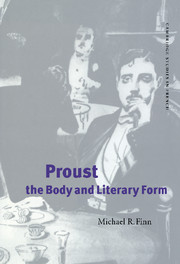4 - Form: from anxiety to play
Published online by Cambridge University Press: 05 November 2009
Summary
The shift in Proust's activity, in the 1907–9 period, from non-fiction to fiction, from what I have called transitive writing to the more personal mode of the novel, brought with it some of the uneasiness associated with writing in pre-creative forms. In this chapter I wish to investigate how certain Proustian anxieties about language, voice, literary genre and fictional structure become embedded features of the novelistic form he finally adopted. In spite of the intellectually satisfying closure of Le Temps retrouvé – it provides us with a newly enlightened Narrator fully equipped with a methodology for inscribing his life into art – there are many aspects of A la recherche that make of it more a work in progress than a fully completed whole. I am not thinking so much of the structural anomalies which the work certainly does display, as of the polemical nature of the Proustian text: it often attempts to reconcile warring elements within itself that remain both visible and visibly irreconcilable.
My objective is not to deconstruct the artistic values presented in Proust's text, but to complete some of the writer's aesthetic stands by pointing to the tensions that underpin them. Proust rails, for example, against the incursion of orality into literature and campaigns to discredit Sainte-Beuve's oral style.
- Type
- Chapter
- Information
- Proust, the Body and Literary Form , pp. 142 - 177Publisher: Cambridge University PressPrint publication year: 1999

